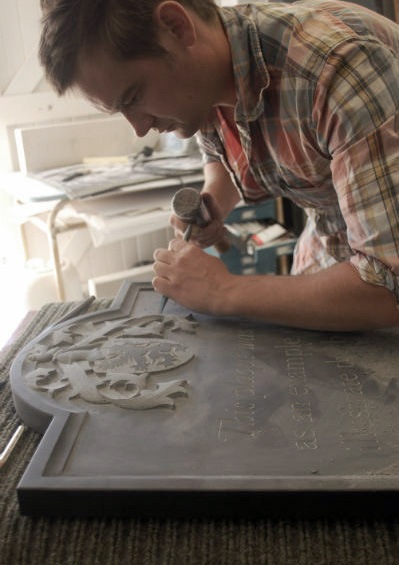Hand carved gravestones
Before the 19th century, gravestones were often carved by the village mason who had little skill or training in typography. The Victorians were the first people to have dedicated letter cutters and this can be seen in their designs and quality of carving. Then with the advent of machinery and the demand for cheaper gravestones much of the skill was lost as once again. This in turn spawned the great lettering revival following the Arts and Crafts movement.
When looking at the early gravestones cut by the local mason, it is clear that there is a lack of planned layout, but in many ways this is what is so appealing about them. The lack of straight lines, the honesty with the carving, the use of space. So often one discovers an old stone where the carver has reached the edge of the stone but not the end of the words and they will carry on vertically. This has a charm, a story. You are aware of the mason's involvement. They sit happily in a churchyard, almost organically, part of the ground.
The manufactured look of the late Victorian designs was seen in the eyes of the Arts and Craft sympathiser as being stiff and slightly unloved. Eric Gill was one of the first people to see this. He went back to basics, but with much skill.
And this battle continues. The mass-produced polish Chinese marble with gold inscriptions sitting awkwardly in a 'on the shelf' shape, versus gravestones which are bespoke: hand carved with designs which have been given much thought and consultation with those commissioning the work. The technique of carving with mallet and chisel is far superior to that of machine cutting; the v-cut section of the letter can really only be made well with a chisel. The letters will also have entisis and will lack straight lines and uniformity. However it is not so much the carving techniques that make the difference. It is typography; the layout, the letter-spacing, the inter-linier spacing, the shape of the stone must work with the inscription. All these points are sadly so often missed by the monumental mason.

When carving by hand, one has the scope to change a letter by widening or narrowing to improve the letter spacing. This cannot be done with stencils. The rhythm and form of the letters is greatly enhanced by this freedom with the chisel.
Why therefore are our churchyards and cemeteries still full of these polished, off the shelf memorials? One answer is that they are very cheap to produce. Another could be that customers are steered towards the quick, cheap and profitable solution by a funeral director. I think the best explanation however is that people simply are not aware of the difference or choice until it becomes standard, which I don't think will ever happen.
Although computers have taken some craft skills away, the internet has made it possible for people to find letter cutters who love their craft which is so visible in their work. One such person is Fergus Wessel from the UK, who specialises in hand carved gravestones and opening plaques.